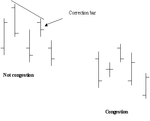As far as I am concerned, you are right the first chart isn't a 1-2-3, and the second one is.
How long do you wait?
After number 2, you have a pullback, as long as it is pulling back, you don't enter as you don't know what it is going to do, for all you know it could keep going down further than your first bar - that would then invalidate your original number 1 bar. Anyway, you wait for it to pullback - it doesn't make it as low as the number 1, then starts to climb again.
For me, I would enter when the high of your number 3 point was breached, my stop would be just below the low of number 3 bar. This is how long I would wait, others will wait until the high of the number 2 bar is breached.
If intra day though, It would be a Nasdaq stock and I would be watching the L2 screen, that way I have more chance of being able to see the likely trend of the stock.
How long do you wait?
After number 2, you have a pullback, as long as it is pulling back, you don't enter as you don't know what it is going to do, for all you know it could keep going down further than your first bar - that would then invalidate your original number 1 bar. Anyway, you wait for it to pullback - it doesn't make it as low as the number 1, then starts to climb again.
For me, I would enter when the high of your number 3 point was breached, my stop would be just below the low of number 3 bar. This is how long I would wait, others will wait until the high of the number 2 bar is breached.
If intra day though, It would be a Nasdaq stock and I would be watching the L2 screen, that way I have more chance of being able to see the likely trend of the stock.

